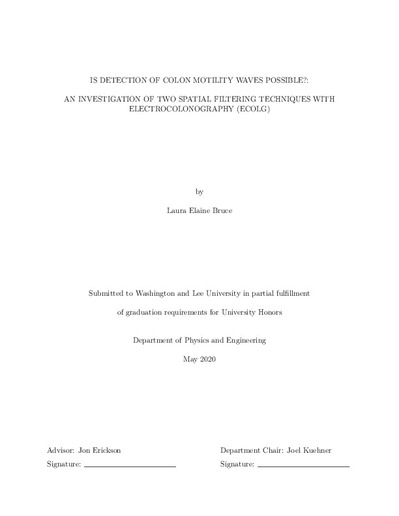Is Detection of Colon Motility Waves Possible?: An Investigation of Two Spatial Filtering Techniques with Electrocolonography (EcolG) (thesis)

View/
Author
Bruce, Laura Elaine
Subject
Washington and Lee University -- Honors in Physics
Colon (Anatomy) -- Motility
Technological innovations
Beamforming
Diagnosis
Technological innovations
Metadata
Show full item recordDescription
Thesis; [FULL-TEXT FREELY AVAILABLE FOLLOWING A 5-YEAR EMBARGO] Laura Elaine Bruce is a member of the Class of 2020 of Washington and Lee University. Electrocolonography (EcolG) is the study of colon motor activity via non-invasive, body surface electrical recordings, analogous to electrocardiography (ECG) for study of cardiac motor activity. EcolG was very recently validated as the first non-invasive technique to identify post-meal colon motor activity concordant with high resolution manometric (HRM) studies. It has identified large increases in colonic motility and can roughly localize activity in the lower left abdomen. The motivation behind further study and development of EcolG is to accurately identify colon motility patterns, which is an essential prerequisite for colon motility research and diagnosis of colon motility disorders. The current limitation with EcolG is the precision with which internal sources can be localized and tracked as propagating waves over time. The objective of this thesis is to use multichannel electrical body surface recordings to identify colonic motor patterns (CMPs) found in high resolution manometric (HRM) studies. We develop and investigate two spatial filtering techniques: Linearly Constrained Minimum Variance (LCMV) spatial filtering and Body Surface Laplacian (BSL) spatial filtering with REGROUPS event marking. The results we obtained from the LCMV show that this method is not suitable for wave propagation. However, we have identified antegrade and retrograde CMPs with the BSL spatial filtering with REGROUPS event marking that are fully consistent with published HRM studies in two separate post-meal time segments of one human study. These results are unprecedented and hopefully inspire further development. Further analysis and advancements in event marking are required for frequent identification of CMPs in multiple human studies; paired x-ray, EcolG, and HRM studies are needed for full validation of this technique; and further validation is needed to extend EcolG to clinical research on colon motility disorders.